
Transformer could advance several key technologies to achieve an operational VTOL system with a more compact footprint than those of conventional helicopters and couples this with higher cruise speeds
Illustration by Doug Moore
With Transformer (TX), the Defense Advanced Research Projects Agency (DARPA) is giving ‘off-road’ an entirely new meaning. Lockheed Martin’s Skunk Works® is leading a team with Piasecki Aircraft to develop the next generation of compact, high-speed vertical takeoff and landing (VTOL) unmanned payload delivery systems under the Transformer program.
Transformer’s unique design could adapt to multiple missions with interchangeable payloads, including cargo pods, medical evacuation units, a tactical ground vehicle, armed scouts, and reconnaissance and strike capabilities. This flexibility combined with emerging autonomous unmanned air vehicle control systems could provide terrain-independent transportation and cargo supply capability to dispersed ground combat units. When compared to a standard helicopter, Transformer’s tilting ducted fans allow for a safer operating environment in smaller landing zones with faster transit speeds of up to 200 knots.
The Pentagon’s Defense Advanced Research Projects Agency, better known as DARPA, has a reputation for applying innovative solutions to practical problems. Getting personnel and vehicles off of roads with known threats, such as improvised explosive devices, or IEDs, is one such problem. DARPA is addressing this problem in a program called Transformer.
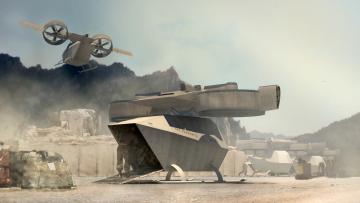
The ducted fan VTOL flight module designed for Transformer could adapt to multiple missions with interchangeable payloads. The payloads could include cargo pods, medical evacuation units, a tactical ground vehicle, troops, and armed scout, reconnaissance, and strike capabilities.
“Transporting and resupplying troops in rugged, austere terrain has become a major challenge, especially as the US military shifts to using smaller and more distributed combat units,” explained Kevin Renshaw, Lockheed Martin Skunk Works lead on Transformer.
The Skunk Works formed a team in 2010 with Piasecki Aircraft Corporation and Ricardo, Inc. that was selected for the DARPA Transformer program. In the first phase of the program, the Skunk Works team performed trade studies and designed the system concept for Transformer.
The program, currently in Phase 3, seeks to develop a new generation of compact, high-speed vertical takeoff and landing, or VTOL, delivery systems.
In its original requirements for Transformer, DARPA asked participants to “demonstrate a four-person flyable/roadable vehicle that provides the warfighter terrain-independent mobility…. The vehicle will have VTOL capability with a minimum combat range of 250 nautical miles on a single tank of fuel.”
The scope of the program has since been refined to focus on the common VTOL lift module that could adapt for multiple missions with interchangeable payloads.
“Transformer could advance several key technologies to achieve an operational VTOL system with a more compact footprint than those of conventional helicopters and couples this with higher cruise speeds,” Renshaw noted. “We created a technology maturation plan that leads to an operational design.”
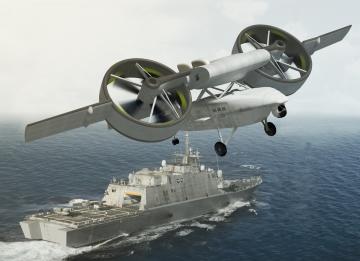
The tilting ducted fans allow for a safer operating environment by combining faster transit speeds with a landing zone half the size of a typical helicopter with a similar payload.
After being selected for the second phase of DARPA’s Transformer program in 2011, the Lockheed Martin team matured its concept and completed a preliminary design review with DARPA and other technical experts in 2012.
The preliminary design was the basis for the Phase 3 effort, which involves designing and building the prototype system. Lockheed Martin won the $20.3 million Phase 3 contract in late 2012 to perform detail design work and risk reduction tests that lead to a Critical Design Review. Following this review, DARPA will decide if it will exercise a further option to build and then fly the prototype in 2015.
Lockheed Martin has a head start in developing and fielding unmanned VTOL systems with the K-MAX unmanned cargo helicopter currently in operation with the United States Marine Corps in Afghanistan. K-MAX helicopters are flown by remote pilots with navigation automated between mission waypoints and payloads carried on an external cargo sling.
Engineers with Lockheed Martin Mission Systems and Training demonstrated the use of these unmanned helicopters to deliver more than three million pounds of cargo to the Marines. The system reduced their exposure of the military personnel to IEDs by tens of thousands of hours. The success of K-MAX in Afghanistan led the Marines to extend the demonstration indefinitely.
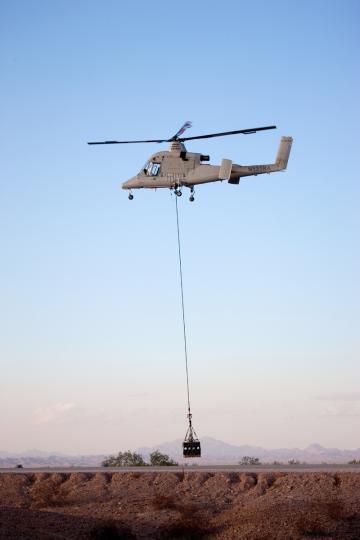
Lockheed Martin has a head start in developing and fielding unmanned VTOL systems with the K-MAX unmanned cargo helicopter currently in operation with the United States Marine Corps in Afghanistan. K-MAX helicopters are flown by remote pilots with navigation automated between mission waypoints and payloads carried on an external cargo sling.
Mission Systems and Training is also under contract to the Office of Naval Research to demonstrate advanced sensors and controls for VTOL unmanned air systems, or UAS, under the Autonomous Aerial Cargo Utility System, or AACUS, program.
AACUS will test sensors and flight control software to allow the next generation of VTOL UAS to autonomously identify landing zones, avoid obstacles, and complete landings without a remote pilot. The system will be designed to be programmed by soldiers and Marines in the field, with simple, intuitive control interfaces, such as military smart phones or ruggedized tablet computers. This technology ties directly into Transformer as part of the maturation path from the DARPA prototype to the fully operational system.
The ducted fan VTOL flight module designed for Transformer could adapt to multiple missions with interchangeable payloads. The payloads could include cargo pods, medical evacuation units, a tactical ground vehicle, troops, and armed scout, reconnaissance, and strike capabilities. The tilting ducted fans allow for a safer operating environment by combining faster transit speeds with a landing zone half the size of a typical helicopter with a similar payload.
One of the original requirements for Transformer was to reconfigure it into a package small enough to drive down a one-lane road. So the system could be, at most, 8.5 feet wide and 30 feet long. “Road width determined the size of the ducted fans,” Renshaw said. “The restrictions lead to a system that could fit into small ship hangars or into C-130 transports. The ducted fan design, with no exposed rotors, would also improve troop safety on the ground.”
The ability to use the same flight module to perform multiple missions with a common system could reduce fleet costs. Transformer could supplement more expensive specialized helicopters that require trained crews. “The modular concept enhances the original DARPA vision by enabling a variety of roles, offering versatility now and adaptability in the future,” Renshaw added.
The transitions to and from vertical flight for takeoffs and landings would be done automatically. The operational version would autonomously navigate to the desired delivery site while avoiding obstacles en route or in the landing zone.
The design is taking full advantage of the digital fly-by-wire VTOL control work that Lockheed Martin has done in the past fifteen years with the X-35 and F-35 programs. The design also benefits from the team’s previous experience with autonomous control of unmanned air systems. “Operating this type of system in VTOL, transition, and cruise flight requires a fly-by-wire flight control system,” said Renshaw.
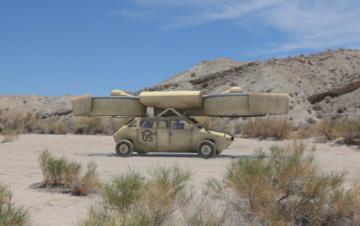
One of the original requirements for Transformer was to reconfigure it into a package small enough to drive down a one-lane road. So the system could be, at most, 8.5 feet wide and 30 feet long.
Piasecki Aircraft, a long established helicopter and VTOL research company, is responsible for the flight module design, including the design of the lift system drivetrain. Frank Piasecki invented the dual rotor system for helicopters in the 1950s. Dual rotors are used today on the CH-46 Sea Knight and CH/MH-47 Chinook helicopters. The company’s previous ducted fan VTOL experience includes its VZ-8 AirGeep series of demonstrators. Piasecki has also studied the potential for lift system modularity under the US Army Combat Medic casualty evacuation project.
The scope of the Transformer prototype program has been refined to emphasize the development of the flying part of the modular system for the initial demonstration. Flight testing of the prototype will now demonstrate the modular flying portion of the system as a UAS instead of flying a manned system controlled by a test pilot seated within Phase 2 work.
“The operational system was always meant to have the capability to be flown as a highly autonomous UAS with the flight module able to return to base after dropping off the car,” Renshaw explained. “The operational design will still be able to carry the car as one of its many payloads.”
For Phase 3, the Lockheed Martin team is creating detailed drawings of the hardware for a full-scale prototype flight module. The hardware would include the structure, drive shafts, propellers, control actuators, and lift system drivetrain gearboxes.
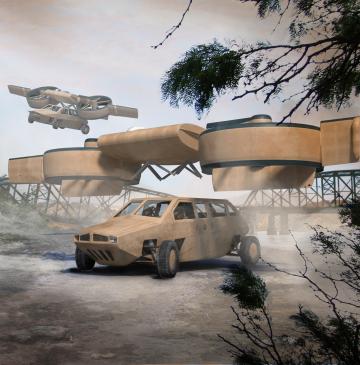
The ability to use the same flight module to perform multiple missions with a common system could reduce fleet costs. Transformer could supplement more expensive specialized helicopters that require trained crews.
The team is identifying existing flight control computers to be used for the digital flight control system. The team is also selecting sensors, GPS navigation aids, and datalinks for the UAS operation. Long lead items, such as gears and bearings, are being ordered to support initial drivetrain tests scheduled for 2014.
“Existing helicopter turboshaft engines will power the prototype,” explained Renshaw. “The team is selecting available components wherever possible to minimize the cost of the prototype.”
The team is also creating the digital flight control laws and flight control software to manage hover, transition, and cruise flight. Simulations of the control and handling qualities of the system are running in the flight controls labs. These simulations are designed to lead to the release of the software package for hardware-in-the-loop tests and flight tests.
The team is also building a one-third-scale powered wind tunnel model to test in the fall of 2013. The wind tunnel tests would characterize the aero and propulsion effects across the full range of thrust, duct angle, and control inputs. This data would then be used to finalize the flight control laws and software for the prototype.
Construction of the prototype will begin with the ducted fan drivetrain, propellers, and tilt mechanism. Duct structure, flight controls, and electronics will be added next. Tests of the complete system on a ground test stand will be used to measure thrust and control responses. The test stand will also allow tests of failure modes and emergency procedures with flight hardware and software in a controlled environment.
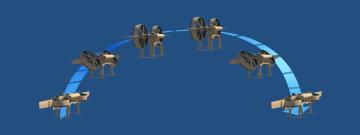
Lockheed Martin won the $20.3 million Phase 3 contract in late 2012 to perform detail design work and risk reduction tests that lead to a Critical Design Review. Following this review, DARPA will decide if it will exercise a further option to build and then fly the prototype in 2015. Illustration by Doug Moore
The program would conclude with demonstrations of the flight module’s ability to perform vertical takeoffs, hover, make smooth transitions between hover and forward flight, and meet predicted flight performance. After the prototype proves that it can fly as predicted, additional tests with a variety of payload types could be performed. Specifics of those tests would depend on service user requirements. “We’re contacting operators from the United States Marine Corps, US Army, and Special Operations Command to help identify how they would use this system in the field,” said Renshaw.
“Once fully developed, Transformer could provide future commanders increased flexibility and options for transporting personnel, performing reconnaissance missions, and supporting troops in the field,” Renshaw concluded. “The ability for small units in the field to get in and out of compact, austere forward bases and to move supplies or evacuate wounded troops without having to schedule high demand helicopters could revolutionize dispersed operations.
Source: Lockheed Martin and Code One Magazine








